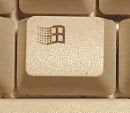Name: Shortcuts aren't always bad
Category: Saving you time (hopefully)
Operating System: MOST
Difficulty: My grandma has the skills to do this and therefore so do you!
Have you ever been clicking away with your mouse (copy and paste, copy and paste, file and open) and thought to yourself there has to be a better way. Well I am posting today to tell you there is a better and (slightly) quicker way to do things on you computer.
What is a keyboard shortcut...?
Well like when you drive in a car and take a shortcut it saves you time (unless you are my wife), keyboard shortcuts save time for common tasks that people usually do with their mouse. Some shortcuts are built into your keyboard like:
- Home key
- End Key
- Page down key etc.
- CRTL key
- ALT Key
- Shift Key
The most popular keyboard shortcuts in Windows (these may also work on other operating systems and many programs that run in Windows):
Remember to hold down the first key if there is another key after it (CRTL + V means hold control key and press v)
- CTRL+C (Copy)
- CTRL+X (Cut)
- CTRL+V (Paste)
- CTRL+Z (Undo)
- DELETE (Delete)
- SHIFT+DELETE (Delete the selected item permanently without placing the item in the Recycle Bin)
- CTRL while dragging an item (Copy the selected item)
- CTRL+SHIFT while dragging an item (Create a shortcut to the selected item)
- F2 key (Rename the selected item)
- CTRL+RIGHT ARROW (Move the insertion point to the beginning of the next word)
- CTRL+LEFT ARROW (Move the insertion point to the beginning of the previous word)
- CTRL+DOWN ARROW (Move the insertion point to the beginning of the next paragraph)
- CTRL+UP ARROW (Move the insertion point to the beginning of the previous paragraph)
- CTRL+SHIFT with any of the arrow keys (Highlight a block of text)
- SHIFT with any of the arrow keys (Select more than one item in a window or on the desktop, or select text in a document)
- CTRL+A (Select all)
- F3 key (Search for a file or a folder)
- ALT+ENTER (View the properties for the selected item)
- ALT+F4 (Close the active item, or quit the active program)
- ALT+ENTER (Display the properties of the selected object)
- ALT+SPACEBAR (Open the shortcut menu for the active window)
- CTRL+F4 (Close the active document in programs that enable you to have multiple documents open simultaneously)
- ALT+TAB (Switch between the open items)
- ALT+ESC (Cycle through items in the order that they had been opened)
- F6 key (Cycle through the screen elements in a window or on the desktop)
- F4 key (Display the Address bar list in My Computer or Windows Explorer)
- SHIFT+F10 (Display the shortcut menu for the selected item)
- ALT+SPACEBAR (Display the System menu for the active window)
- CTRL+ESC (Display the Start menu)
- ALT+Underlined letter in a menu name (Display the corresponding menu)
- Underlined letter in a command name on an open menu (Perform the corresponding command)
- F10 key (Activate the menu bar in the active program)
- RIGHT ARROW (Open the next menu to the right, or open a submenu)
- LEFT ARROW (Open the next menu to the left, or close a submenu)
- F5 key (Update the active window)
- BACKSPACE (View the folder one level up in My Computer or Windows Explorer)
- ESC (Cancel current task)
- SHIFT when you insert a CD/DVD into the drive (Prevent it from automatically playing)
Windows only shortcuts:
These are Windows only shortcuts. To use these hold down the Windows logo on your keyboard and then press the desired key (it will look something like this)

- Windows Logo (Display or hide the Start menu)
- Windows Logo+BREAK (Display the System Properties dialog box)
- Windows Logo+D (Display the desktop)
- Windows Logo+M (Minimize all of the windows)
- Windows Logo+SHIFT+M (Restore the minimized windows)
- Windows Logo+E (Open My Computer)
- Windows Logo+F (Search for a file or a folder)
- CTRL+Windows Logo+F (Search for computers)
- Windows Logo+F1 (Display Windows Help)
- Windows Logo+ L (Lock the keyboard)
- Windows Logo+R (Open the Run dialog box)
- Windows Logo+U (Open Utility Manager)
There are literally hundreds more, but I will be posting some more (firefox and Internet explorer) later if you would like to keep updated on my tips you might consider subscribing to this blog.
No comments:
Post a Comment